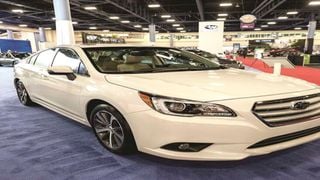
A Subaru Legacy.
| Pool | Nation Media GroupDN2
Premium
Desperate case of Rumion with skirting that gives it low ground clearance
What you need to know:
- Once the converter is removed, the vehicle is no longer clean.
- The exhaust gases are free to corrupt the atmosphere in all their noxious, carcinogenic glory.
Dear JM,
Thank you for your very informative column on motoring and the stylistics used therein to deliver. You surely have a talent in writing too. If appropriate, kindly allow me to raise two issues which are totally unrelated.
First issue
A close relative wanted to buy a nice budget vehicle and was considering the Toyota IST, Auris and Toyota Rumion. She fell for the 1800 Cc Rumion due to its elegant beauty, space and engine power.
As you review the three vehicles, kindly advise on how to raise the car as it came with a skirting which gives it a low ground clearance. The rims are size 15-inch out of the factory recommended 15/16.
I have seen a similar model fitted with size 18-inch rims but I advised her to raise hers by fixing heavy duty coil springs. Please advise.
Second issue
I don’t like rumours and neither do you, but rumour has it that some unscrupulous people are removing catalytic converters from newly imported vehicles for resale in an undisclosed market.
My question is, what would be the negative effect on a car without a catalytic converter and what else would such a gadget be used for other than in a vehicle?
From GN
Hello GN
You are very correct, I do not dabble in rumours, less so the unverifiable kind. The pilferage of onboard desmogging kits from motor vehicles is not conjecture, it is fact - global fact, to be precise. They're not just stolen from newly imported cars, any vehicle whose owner is naïve enough to leave unsupervised around people they shouldn't really trust will have its skirt lifted, its purity besmirched and its innocence taken by elements not entirely of good character.
I did not throw in that uncomfortable analogy for shock value, it is part of the response to your question: the downsides of decatting a car, unwittingly or otherwise. Once the converter is removed, the vehicle is no longer clean. The exhaust gases are free to corrupt the atmosphere in all their noxious, carcinogenic glory as they burn the sky and poke a bigger hole in the ozone layer, coaxing mankind onward with fresh urgency towards the end of his existence as a species.
I am a scientist and I love chemistry, same way as I am an author-writer and I love analogies. Chemistry is a strange and beautiful subject, especially where it meets biology - paradoxes and antagonisms abound, and here is one: Hydrogen is the most abundant element in the universe, but paradoxically, it is also the most difficult to acquire. That is because it forms relationships with other elements stronger and more stable than a cryptocurrency password.
Well, in biology we are taught that we need to breathe in oxygen to survive, but, paradoxically, once this oxygen combines with other elements, it stops being a lifeline and becomes straight up toxic, like an age-inappropriate relationship. Anything with its name ending in "oxide" is either poison or a noxious vapor, and there are plenty of them that come out the exhaust pipe of a car.

A catalytic converter.
Fuel is mostly hydrocarbons, with various sulphur and nitrogen-based additives to control combustion properties, clean and generally extend engine life. Combustion is oxidation: chemical addition of oxygen in an exothermic reaction ("burning") and it is from here that we get our various poisons: the oxides.
We have oxides of nitrogen (including the famous "laughing gas", which is not as good as it sounds), we have oxides of carbon - including the notorious twins, mono and di -, we have oxides of sulphur, which when mixed with water forms sulphuric acid... you can see what this list looks like: the ingredients of a malevolent fog designed specifically to cook our lungs and sear our gullets from the inside out.
So, there you have it. The catalytic converter traps these poisons and keeps them from ripping the sky apart any worse than it already is, therefore removal of the seine between your engine block and all our lungs leave said lungs exposed to filth with which comes health problems and the gradual "uninhabitability" of Mother Earth.
Also, your dashboard will light up, but these lights can be very easily deleted, think more of the future generations and what kind of masks they'll be forced to wear, not because they'll be hiding from a virus like us, but because without the mask they'll be inhaling acid - acid that we put there by stealing one another’s catalytic converters.
These catalytic converters contain some rare earth elements (the earth gives us and we give back by defiling it) that are very expensive. They're costly in and of themselves but take a guess what their biggest real-world application is... Yes, you're right, the manufacture of catalytic converters.
So the undisclosed market you speak of is not so undisclosed, they go right back to where they came from. It is a nefarious and highly ironic form of recycling, if you think about it.
[Please note: much as the rare elements in the catalytic converters find their way back to the manufacturers, this does not in any way imply that the manufacturers are responsible for the thievery thereof.
There is something called a supply chain, and the source end of this chain is murky and highly secretive. You can do vetting as hard as you want, but protectionist tendencies means whoever is getting these rare elements directly from the source will not reveal that source, legitimate or not.
The finder sources the element and sells it to someone who then sells it to someone else who processes it then sells the processed material to yet another person and another and several steps later, it gets to the manufacturer.
The manufacturer cannot tell if the rare elements were dug out of the ground, or created in a lab, or stolen from underneath a carelessly parked Toyota Prius, and efforts to investigate will hit a wall faster than a Prius with no brakes. Welcome to the world of rare earth elements where asking the wrong questions could cost you your life.]
Of course some of these elements (e.g platinum) have other uses elsewhere outside of the automotive industry, but when you are living the outlaw life of pillaging and pilferage, a ready market is very high on your list of priorities. The automotive industry provides a ready market.
***
In light of recent content in this column, I gather that your family member already has the Rumion, so my reviewing the iST and Auris against her new car is not going to change anything, is it?
About the skirting: I will need a picture to determine whether it is factory spec or aftermarket. If it is aftermarket, simply remove it.

Toyota Corolla Rumio.
If it is factory spec, then raising the car is the prudent thing to do - but next time please ask her to buy a taller vehicle if she ventures off the smooth and wide instead of modifying a car to do what it was not designed to do. 16-inch wheels and taller springs ought to pass muster, but again... it's not very advisable since it messes up the steering geometry and raises the center of gravity, making the vehicle more prone to intractability.
Heavy duty shock absorbers sound like overkill, and they will compromise comfort. You don't really need them.
What is it with Baraza and the Subaru Legacy?
Hi,
I am a great reader of your column, but of late I don't have a lot of psyche for this column because of some kind of biasness of the writer. For instance, in Daily Nation, 31 March, a Mr Mikey requested Baraza to talk about the Honda CRV though he had indicated initially that he loved the Subaru Legacy. He did not ask for a review of the Subaru, but the writer gave full attention to it.
He spent about 90 percent of the article talking about the Subaru Legacy, which was not the car in question (Baraza is always biased when it comes to Subarus. Ask him to do a comparative analysis on other cars including a Subaru, be 100 percent assured that he will knock off all other brands in favour of the Subaru.)
Readers deserve very neutral advice which address our questions in a better way.

A Subaru Legacy.
Hello,
The reason behind the popularity, longevity and authority of this column is the emphasis on brutal honesty irrespective of consequence.
We don't canvass anyone out of fear and there are no sacred cows, and this straightforwardness has seen us travel the world on someone's else's coin on a consultancy basis as they sought our expertise on vehicles they intend to release to the African market. This cannot happen if they do not respect your work.
There will always be a winner and a loser, and Subaru keeps winning for reasons I have repeated here so many times (flat engine, robust build, symmetrical AWD, top safety ratings), certain keys on my laptop are starting to show wear and tear, like the head gasket on a high mileage Subaru.
There is a difference between neutrality and fluffy journalism. Around here, we are neutral, meaning no one is safe - anyone and everyone can be called out on their shortcomings, much the same as champions will get their 15 minutes of laudatory remarks, we even have a Car of The Year Award, which Subaru has never won.





